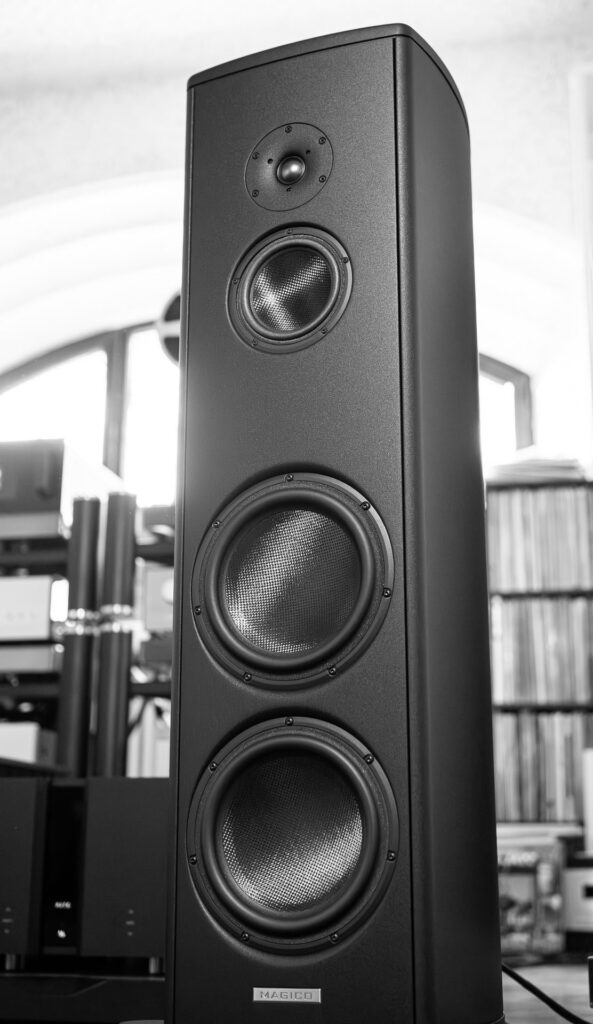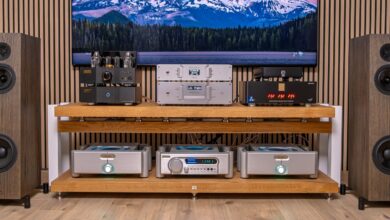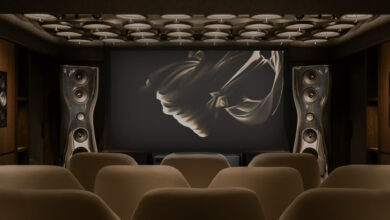Magico S3 Mk III Review – The Vanishing Point of Sound
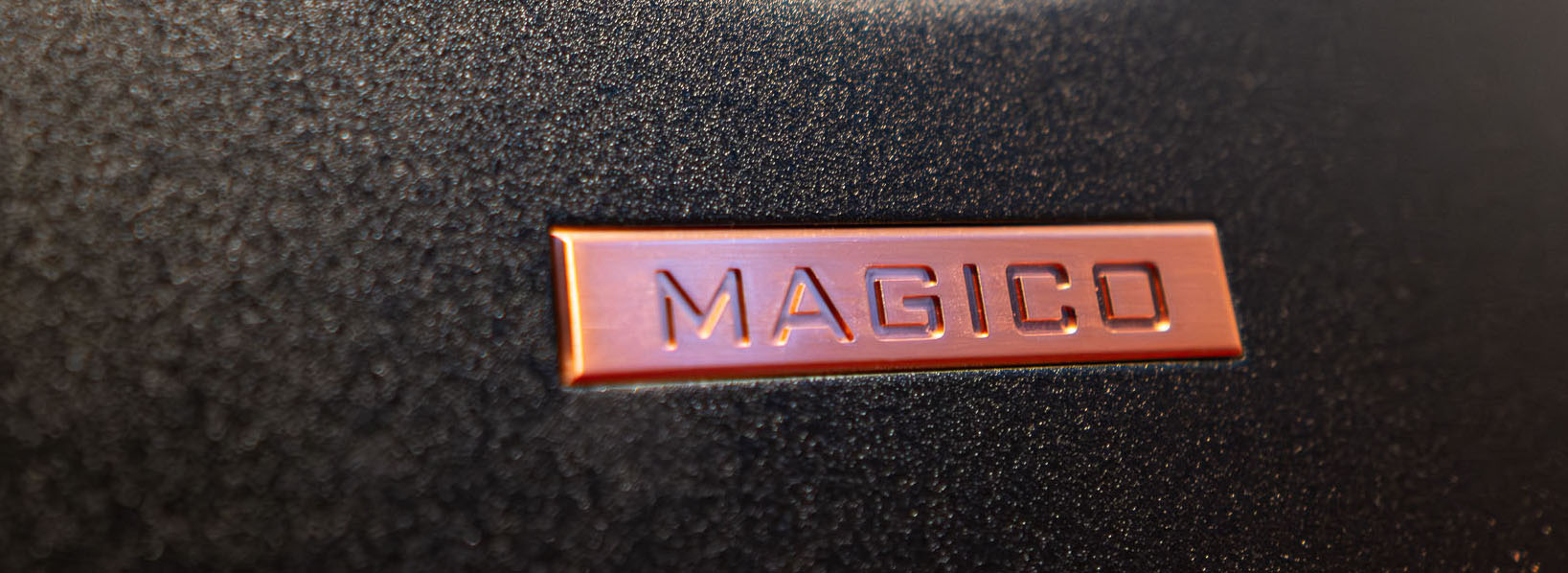
There is an old story told in whispers among those who listen more than they speak, a tale not found in books, but murmured behind closed doors at late-night listening sessions, when the English Sherry Cask filled glass is almost empty and the lights dim low enough to blur the boundary between reality and reverie…
“It is said that once, a man walked into a forest, seeking magic.
He did not know what magic looked like, nor what it sounded like. He had only heard rumors, tales of goosebumps and tears, of notes that floated like fireflies in the air and voices that stepped out of the shadows to breathe intimately directly into one’s ear. He had spent years wandering from clearing to clearing, carrying his favorite records like ancient scrolls, laying them gently before glowing tube monoliths, lacquered wooden cabinets the size of wardrobes, and towering horn-loaded totems. Some spoke sweetly, others shouted. But none whispered truth.
Then, one day, the man came to a clearing unlike the others. It was empty. No altar. No gleaming shrine. Only silence.
He sat down, tired.
And then, in silence, he heard, he felt.
At first, he mistook it for the wind. But the sound took shape, a single piano note. It did not push against the world, it asked nothing of it. It vibrated somewhere deeper, not in the ears, not even in the air, but in his whole body, between breath and thought. Then another, a voice. Not nearby. Not far. Simply there. It was not louder. It was not clearer. It was just right.
He looked around, searching for the source, but the clearing remained empty.
He had found magic, not because it called attention to itself, but because it removed everything else.”
For audiophiles, the word magic is used often, too often to be frank. It’s flung casually across forums and showrooms, usually in moments of post-demo euphoria: “The imaging was magical,” someone will say, or “It had that magic in the midrange.” But when pressed to define it, few can. They talk about transparency. About air. About holography. They reach for metaphors. Yet none of it truly lands.
That’s because the magic they wish to describe is not additive. It’s subtractive. It is not something layered on top of the music. It is what remains when nothing interferes!
This is the philosophy, the obsession let’s say, behind the Magico brand.
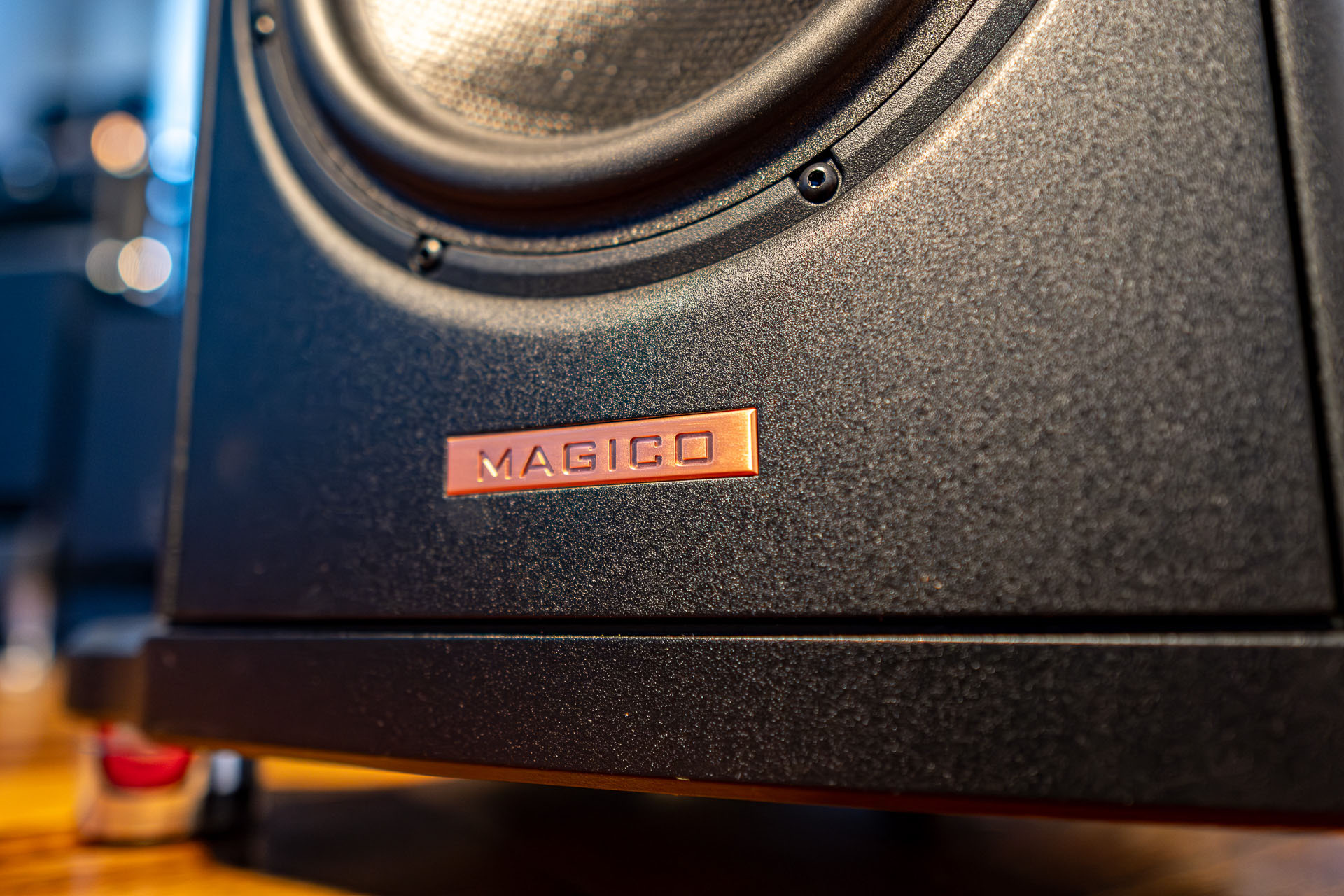
Founded in California by Alon Wolf, Magico is not a speaker company in the traditional sense. They do not build products around trends, or by ear alone. They are closer in spirit to an acoustical research lab masquerading as a luxury manufacturer. Each speaker is the output of dozens of design disciplines: metallurgy, fluid dynamics, electromechanics, data modeling, CNC machining, and above all, listening without ego.
While others tune their house sound, Magico seeks the vanishing point. The fewer fingerprints the speaker leaves on the music, the closer they believe they are to fidelity. Not just in frequency balance or distortion levels, but in time coherence, dynamic linearity, and dispersion behavior. They believe that how a sound leaves a speaker matters just as much as what it is.
They believe a loudspeaker should vanish, not in the physical sense (their 100-kilogram cabinets certainly do not disappear) but in the auditory sense. If the listener is thinking about the speaker, something has gone wrong.
This ideology explains their material choices. Aluminum for the enclosure, while expensive to machine and difficult to work with, is dimensionally stable and acoustically inert. Beryllium, though fragile and costly, is one of the stiffest and lightest diaphragm materials available. Graphene, exotic, futuristic appears not in marketing brochures but in their bass drivers. Everything, even the curve of a top plate or the angle of a foot, exists because data said it should.
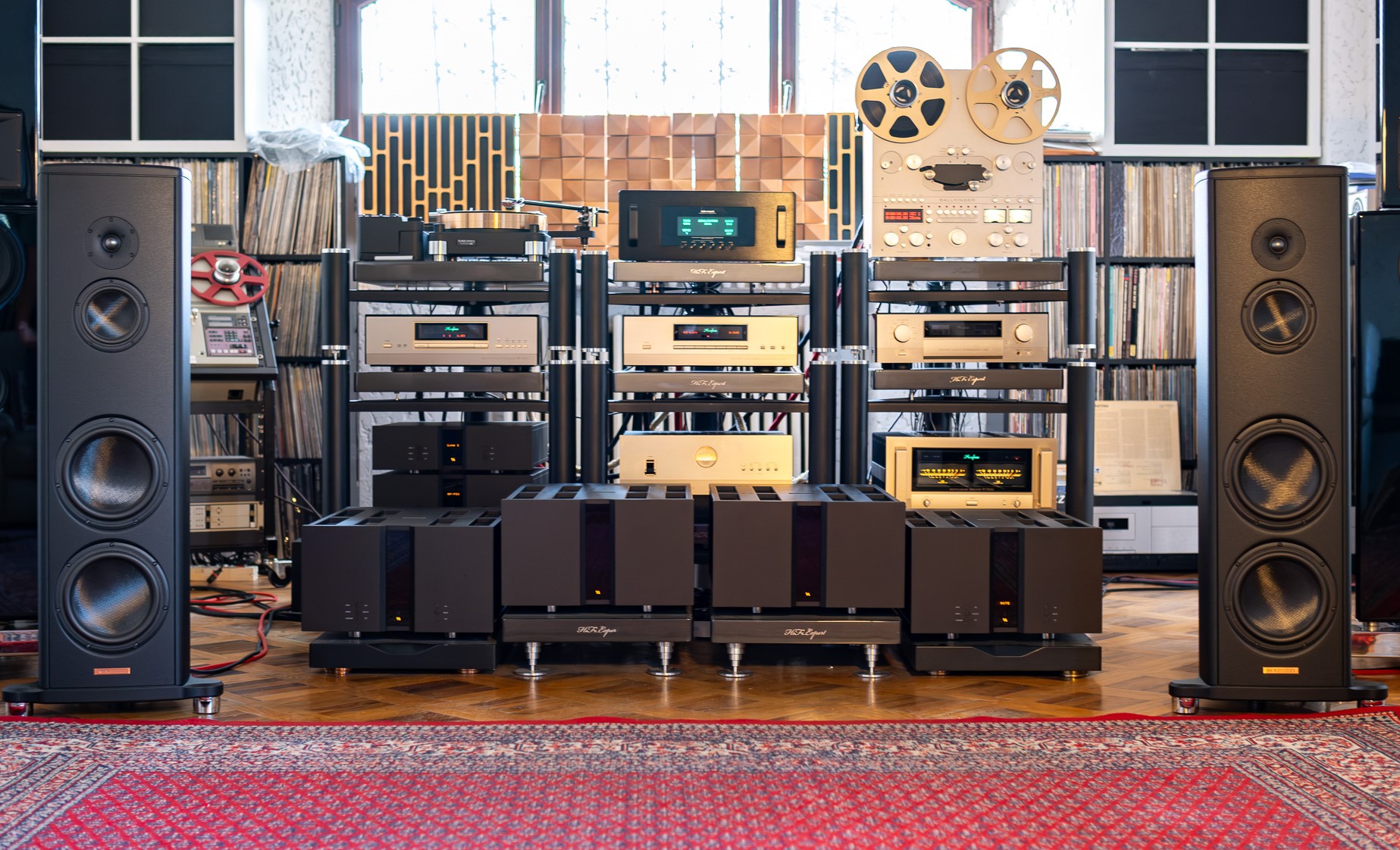
But Magico is not data-driven in the sterile, spreadsheet sense. They use data to reach a place where emotion can emerge unfiltered. Their massive investment in 3D laser interferometry, Klippel scanning, and finite element analysis is not to impress but to disappear. Each layer of engineering is another veil removed.
And when you finally hear what is left behind, when that clearing finally opens in your living room, you begin to understand what so many others tried to describe with the word magic. Not sparkle. Not seduction. But truth.
Magico, as a company, does not advertise loudly. Their speakers do not come wrapped in glossy veneers or adorned with dramatic waveguides. In fact, they can look surprisingly understated, almost plain. But this, too, is part of the spell. They do not want you to marvel at their construction. They want you to forget it exists.
If you were to visit their facility in Hayward, California, and be lucky to also visit their demo room, you might find yourself listening to a track you’ve heard a hundred times. But on the Magico system, you will not hear it the same way.
You will find magic, for that brief moment, you will become the man in the forest and finally understand.
Magico S3
The 2024 revision of the Magico S3, known as the Mk III, is not a facelift. It is not an iteration. It is a ground-up reimagining of what a speaker in this tier can achieve. What began with the monumental M9, a $750,000 statement of no-compromise audio, was reverse-engineered, miniaturized, and distilled into the S3. The DNA remains the same. Only the form is condensed.
Its cabinet is made of four massive, curved, CNC-machined aluminum panels bonded into a shape that resists resonance like stone resists the wind. Each panel ranges from half an inch to two inches (5 cm) in thickness, with internal bracing mapped by laser interferometry, measuring 1000 points per side. One could call that overengineered, and Magico would agree, since their aim was never a price target but an audible vanishing act.

Photo courtesy of magicoaudio.com
Standing just under 1.1 meters tall and weighing 101 kilograms per channel, the S3 is far from lightweight. Magico outfitted it with an outrigger foot system meant to lower its center of gravity and therefore reduce mechanical noise. You will not see these structural refinements; you are meant to hear them as a deeper silence between notes. We are not inclined to accept that claim at face value. We are here to test whether the S3 can indeed vanish into blackness as boldly as promised.
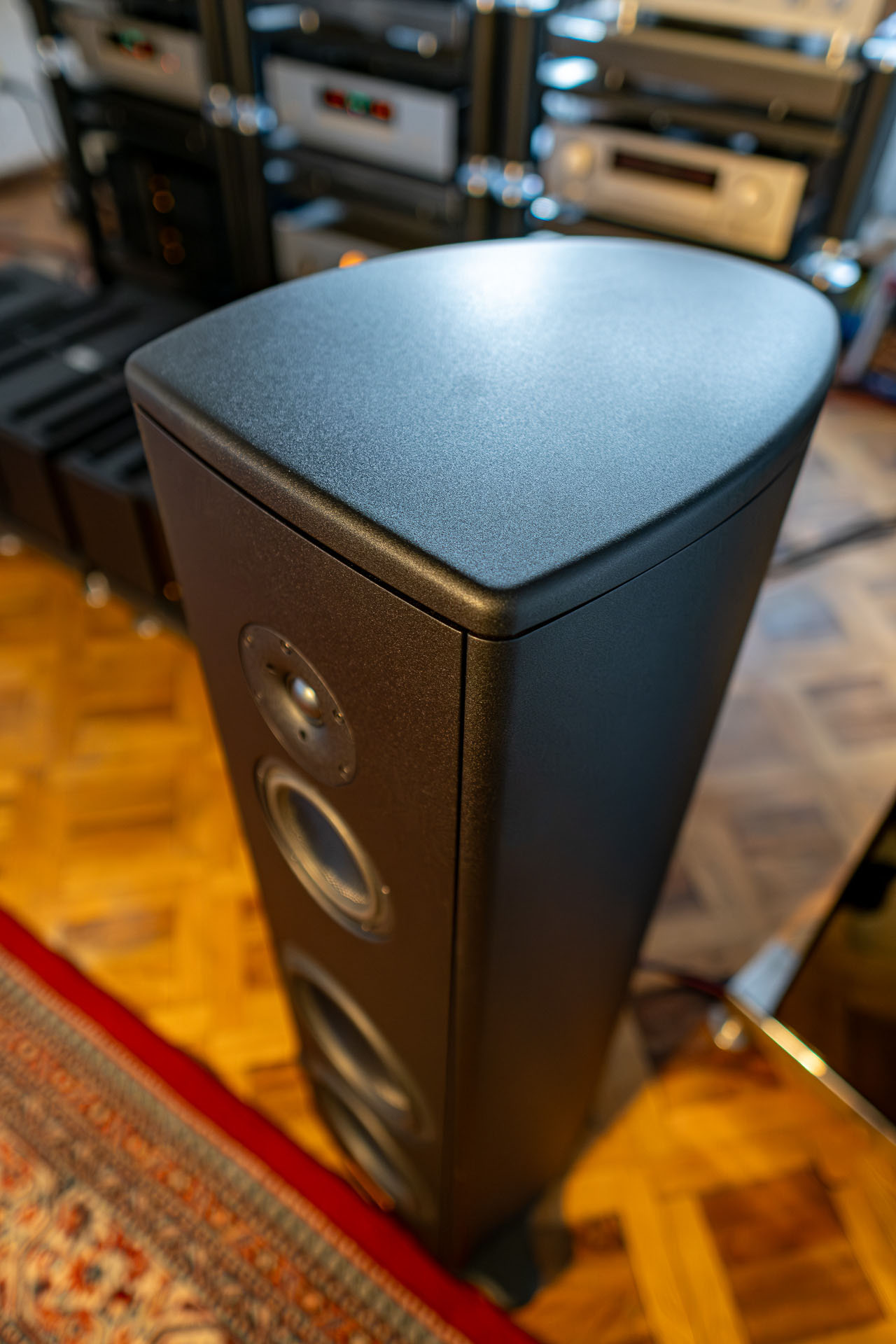
Inside, the S3 is equally uncompromising:
The tweeter is a 28 mm dome made from diamond-coated beryllium. Their intention is to combine the smooth richness of soft-domed designs with the precision of metal domes into a single, more revealing driver. Tuned to extend cleanly beyond 50 kHz, it reproduces shimmer without hiss and detail without hardness. This tweeter shares its core architecture with the flagship M9 unit, adapted to the S3’s form without dilution of its performance goals.
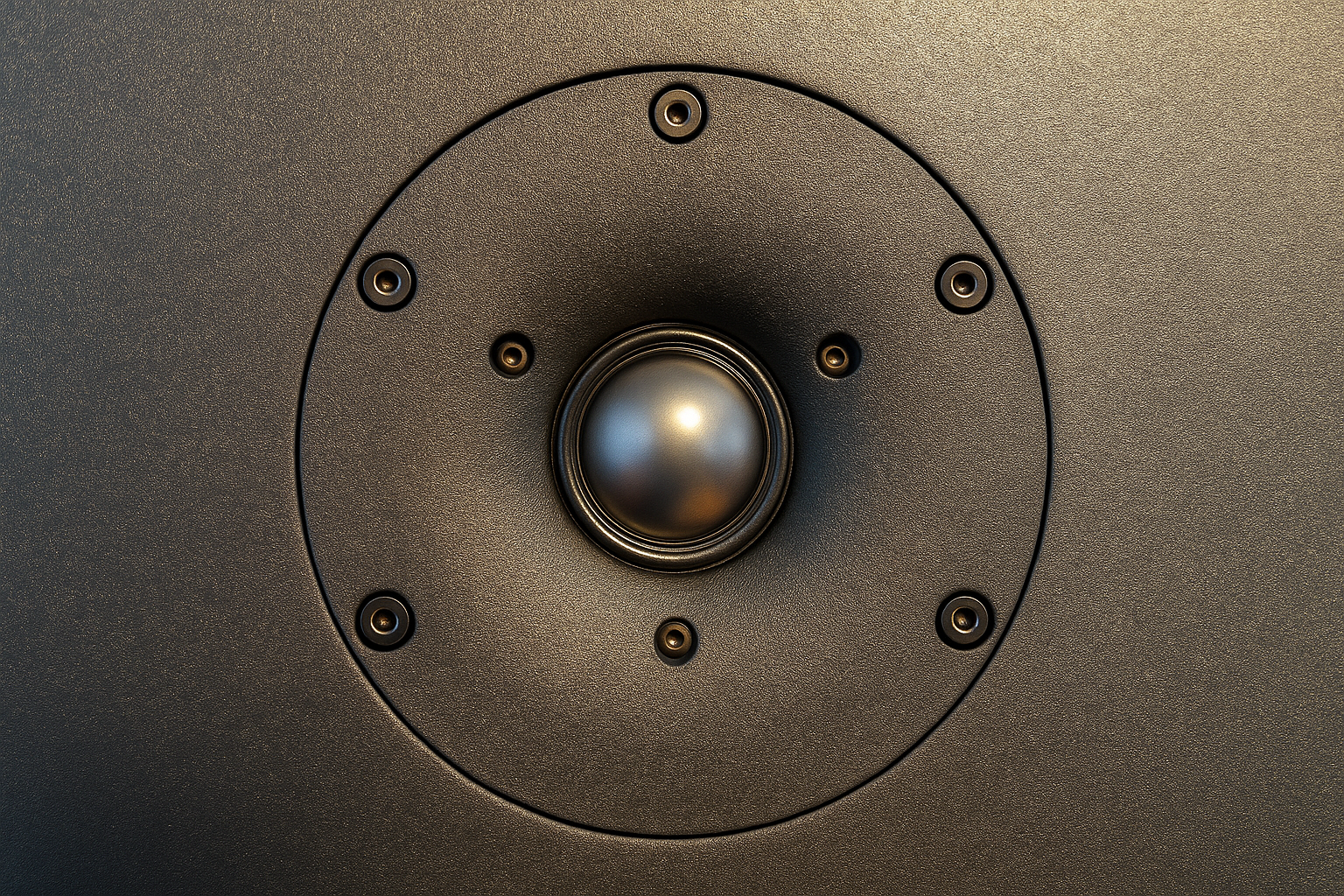
The midrange is a 5” (127 mm) marvel of materials science. An advanced cone material formed of a honeycomb aluminum core sandwiched with outer and inner layers of graphene and carbon fiber. The advanced cone is supported by a customized basket assembly and innovative, long-life foam surround, which helps achieve ideal cone/surround integration, faster settling time, and impressively low distortion. Magico states this development in midrange driver technology sets a new benchmark of measured performance in both the frequency and time domains.
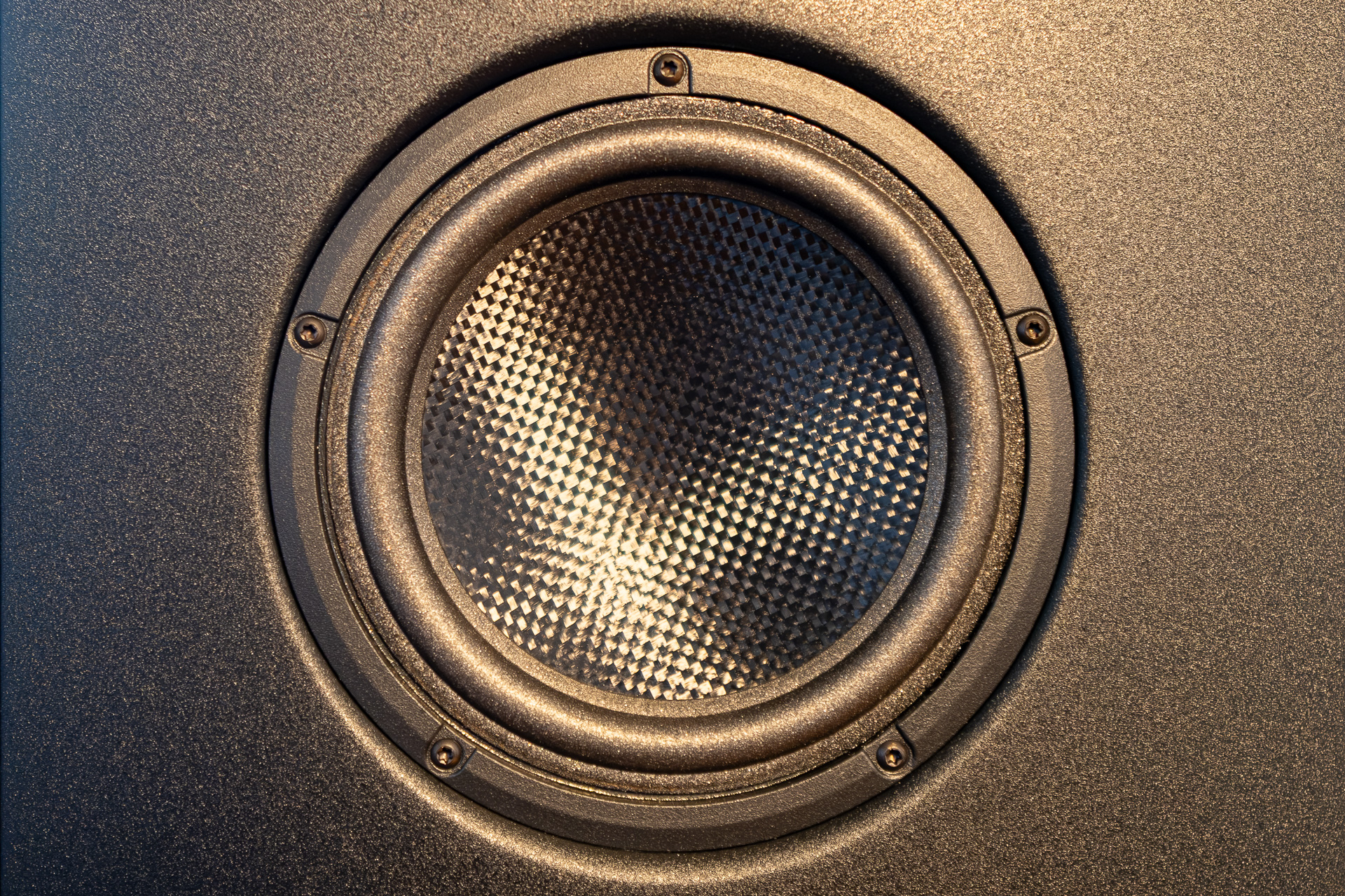
Bass is delivered via two 9” woofers using Magico’s evolved Graphene Nano-Tec cones. With half an inch of linear excursion, 5” titanium voice coil, and distortion levels that live below the threshold of audibility, these drivers move air like sealed subwoofers but without losing composure or timing. The result, Magico states, is a sonic masterpiece that will reveal more listening pleasure than thought possible at this price point.
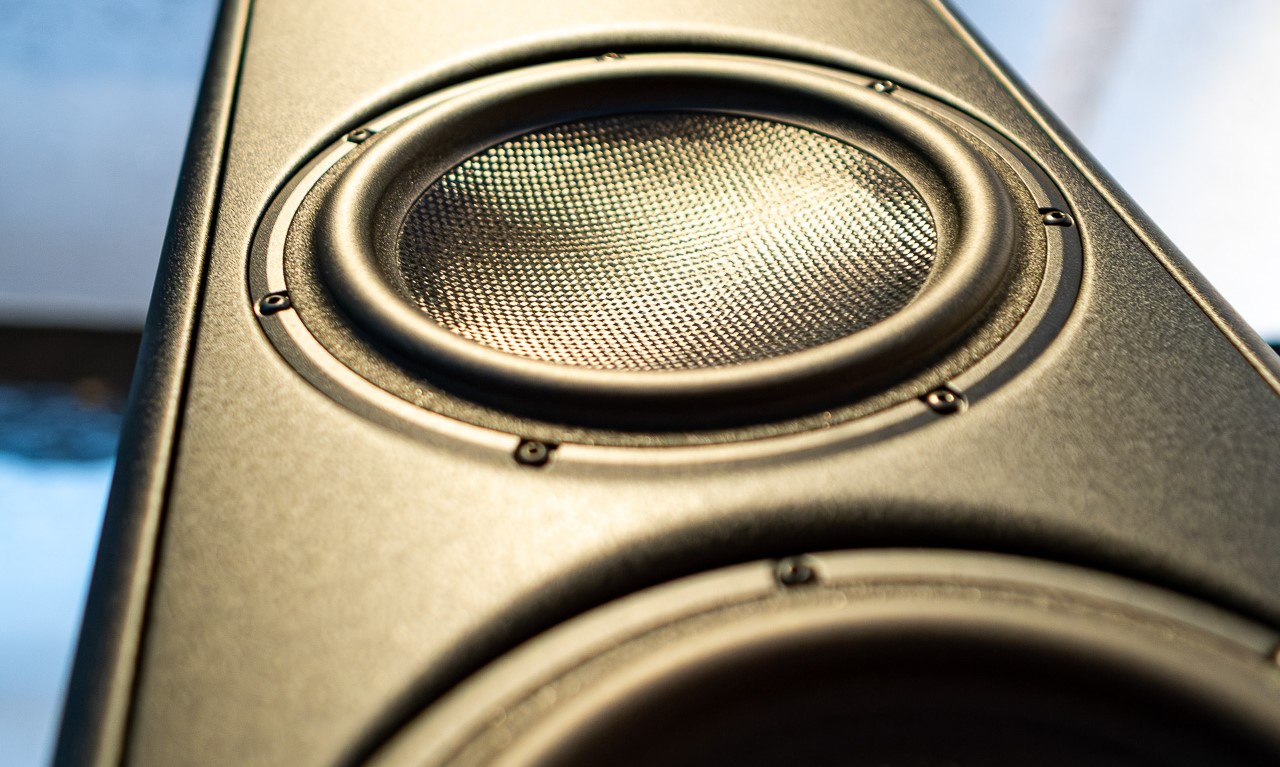
On paper, the numbers are almost mundane: 88 dB sensitivity, 4-ohm impedance, 24 Hz to 50 kHz frequency response. But Magico does not design for specs. They design for disappearance.
They maintain the goal is not to present a speaker that calls attention to itself but to let the music breathe unburdened, as though the transducers have vanished entirely.
We are here to test whether the S3 can live up to that claim!
SPECIFICATIONS
Driver Complement:
1.1″ MB5FP Diamond Coated Beryllium Dome (x1)
5″ Gen 8 Midrange driver (x1)
9″ Gen 8 Bass driver (x2)
Sensitivity: 88dB
Impedance: 4 Ohms
Frequency Response:
24 Hz – 50 kHz
Equipment used and matching
During the evaluation period, I had the opportunity to pair the Magico S3 Mk III with several high-end electronics, each bringing its own character to the listening experience.
One of the most compelling setups featured a complete Accuphase chain, composed of the DP-900/DC-901 SACD transport and DAC, the C-2900 preamplifier, and the P-7500 power amplifier. This particular combination stood out for its exceptional dynamic response and tonal realism. The system as a whole delivered lifelike transients, excellent macrodynamics, and a highly engaging, holographic presentation that allowed the S3 Mk III to truly shine.
In an effort to further explore synergy, I substituted the Accuphase C-2900 with a Vitus Audio MP-L201 MkII preamplifier within the same setup. I felt that some of the vividness and energy were lost in the process. Dynamics were slightly restrained, and a degree of micro and macro-detail and immediacy seemed to be missing in comparison to the all-Accuphase configuration.
Another system employed a full McIntosh stack, including the imposing dual MC1.25KW monoblocks. The high expectations from this set-up was not met. The soundstage appeared flat and congested, with limited depth and layering. Microdynamics were noticeably subdued, regardless of playback volume, and the overall presentation felt more like a wall of sound than an immersive, three-dimensional experience.
Finally, I experimented with a Pass Labs setup consisting of X160.8 monoblocks paired with the XP-32 preamplifier. This system delivered an organic, full-bodied presentation, with a beautiful sense of flow and musicality. Still, in direct comparison, the Accuphase system proved to be superior in terms of speed, transient definition, and sheer dynamic headroom while preserving the beautiful, lifelike presentation that the Pass Labs system was so remarkable for.
Out of all three configurations, the Accuphase setup emerged as my clear favorite. It managed to combine lifelike textures with explosive dynamics, resulting in a playback experience that was both natural and exhilarating, a perfect match for the S3 Mk III’s revealing nature.
Initial listening impressions
These were our first impressions, and we remained skeptical… first impressions can be tricky.
Some systems aim to impress with sheer scale or punch, offering a kind of sonic showmanship that demands attention and never let’s go.
Then there are systems that quietly vanish from view.
The S3 did not announce itself with bass thunder or treble sparkle. At times, we were not even certain it was playing. Ambient noises from creaking floors or distant traffic might have been mistaken for silence, until a single piano note appeared, hovering in space as though conjured from thin air. Then, out of the silence, it just hits you, sometimes with a single note, a piano key gently pressed, so delicately it seemed not to originate from the loudspeaker but from the instrument itself, from a real life piano, dare I say. The note did not surge forward or linger unnaturally. It simply existed, drifting in the room like a memory coming back to life. That note did not feel reproduced. It felt created, carefully, deliberately.
It was the kind of sound that does not ask for your attention. It assumes it.
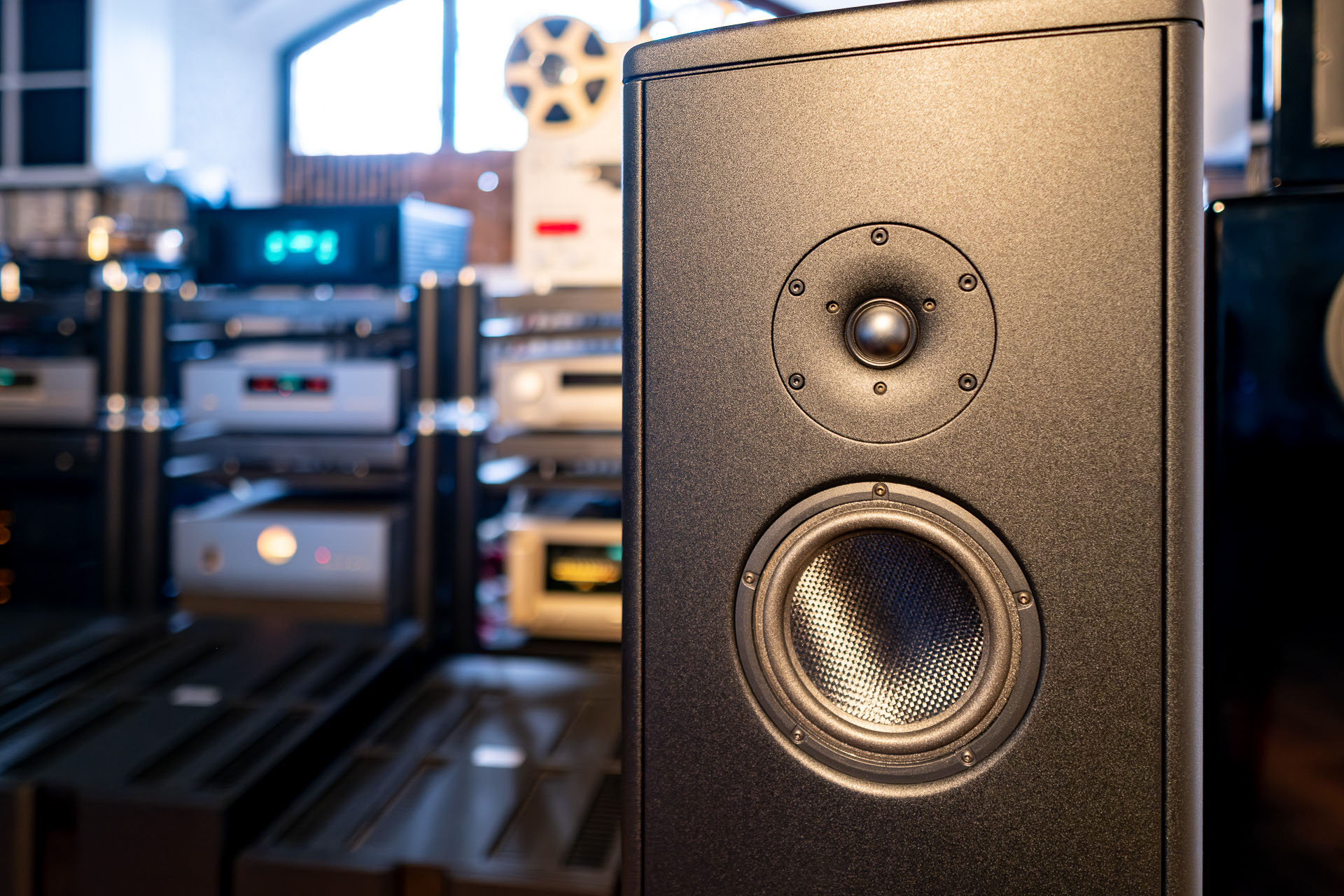
What about the rendition of a voice?… Just as you are curious about it, so were we. We found ourselves wondering if Avi Kaplan himself had stepped into the room, ready to sing. As the thoughts processed, in came the voice, male, low, intimate. No sibilance, no unnatural warmth, just the kind of presence that makes you lean in, instinctively. We could hear the air parting with every breath, the slight imperfections in phrasing, the chest resonance that usually gets flattened in most systems. But none of it felt isolated. It all came together in one seamless gesture. No spotlight. No sharp edges.
When the guitar joined, it didn’t sparkle. It wasn’t in the wrong place, it resonated perfectly with the rest of the existing sounds. Each string had a palpable feeling of elasticity, the vibration of metal over wood rendered with uncanny tactility. We could hear fingers shifting up the fretboard not emphasized, not over-amplified, just natural movement. The overtones hung in the air and then faded like they are supposed to. The timing was rendered very well, like very few other systems manage to do.
We were wondering then, how would a wind instrument sound… and behold a flute appeared, not with flash, but with grace. Its flow subtle and alive. The soundstage expanded, not merely side to side, but into front and back. Depth became a sensation, a feeling, rather than a matter for analysis or critique.
The instruments seemed no longer confined to the speakers’ boundaries; the S3 projected them in such a manner that they appeared to float freely throughout the room.
When we listened to the violin through the S3, its gentle tone conveyed warmth and serenity throughout the room. Each note displayed vivid micro dynamics without a trace of grain or excessive sweetness providing us with pure emotion.
We have heard these instruments countless times, yet rarely in a playback setting did they move us as they did here. Only in an intimate live performance, or in a small room tuned to perfection, have they ever stirred such emotion. In our listening journey, the S3 proved unshowy in its neutrality. It revealed no distortion and added no color for the sake of effect. We felt the S3 was just removing itself from the equation. We have encountered moments of this realism before, but so infrequently that it took us by surprise.

What about the bass then? Well, as the music’s scale unfolded, we realized we were unprepared for the S3’s restrained low end. Its sealed enclosure delivered admirable precision but often times lacked the muscular punch we had hoped for. We anticipated a bigger impact but encountered a polite reserve, perhaps shaped by our room’s acoustics or upstream electronics. Even so, the bass remained articulate, full yet taut, lending gravity without blur or boom. Each note struck with purpose and faded cleanly, leaving no bloom or overhang. Its discipline imparted weight without dominance and underscored the S3’s overall coherence, even as we quietly yearned for greater visceral drive. We will subtly note this measured low-frequency reserve moving forward.
It’s the silence, the emptiness between notes and between sounds where the S3 truly resides. It thrives not in what it plays but in what it leaves uncolored and untouched. Impeccable timing and decay amplify that quietness. We searched for hints of noise, cabinet resonance, or driver fatigue but found none. We did not hear the speaker exert itself. We did not hear anything trying.
It simply let the music exist, aided by timing so precise and decay so natural that the silence between notes carried as much emotion as the notes themselves.
When sound swelled, when vocals layered and harmonies bloomed, we braced for congestion but none arrived. Each line remained distinct yet never detached. Separation without isolation, unity without blur. Treble was full, extended, and astonishingly smooth. No brittleness, no glare, none that we could detect. Only purity that let a cymbal whisper or a triangle float without edge. The diamond coated beryllium tweeter worked unseen. Try as we might, throughout the audition, we never heard a driver, only the instrument playing.
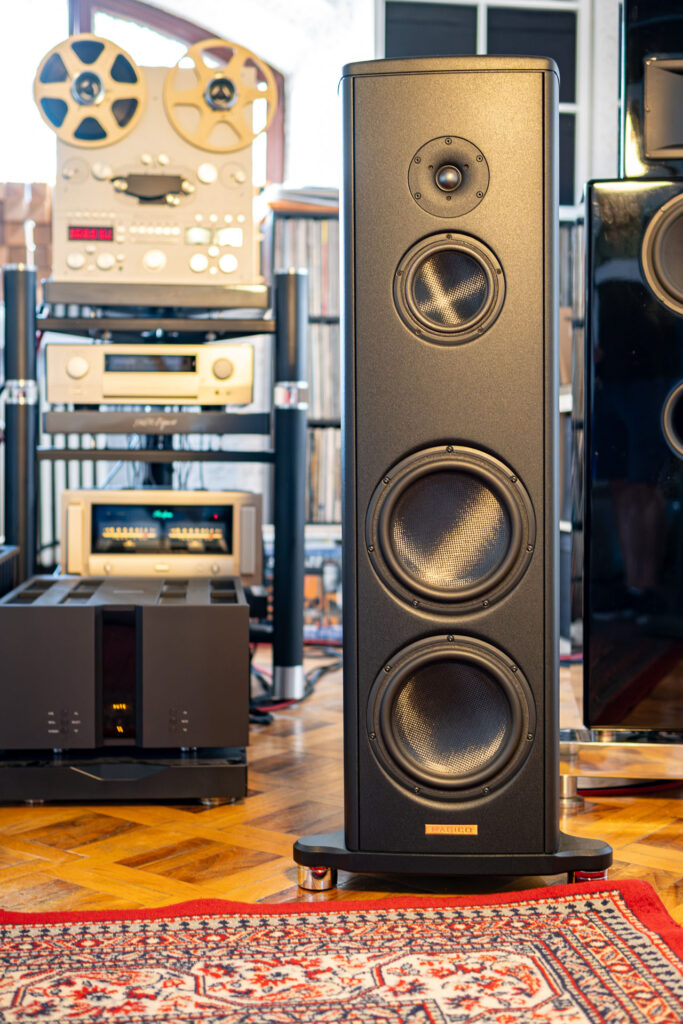
Coherence across bass, midrange, and treble felt like the S3’s best-kept secret and a testament to Magico’s vision. Rarely have we experienced such seamless unity across every frequency band. Each driver ceased to be an individual instrument and instead spoke as one voice, weaving a musical tapestry with uncanny realism. Unlike coaxial designs that promise a single point source yet often introduce tonal unevenness or phase anomalies, the S3 delivered a true center point presentation free of those common drawbacks. We believe this level of coherence and realism sets a new benchmark for transparency and stands as the S3’s most remarkable achievement.
Let’s now proceed track by track and explore how these familiar recordings took on new life through the S3.
Track 0: Tchaikovsky – 1812 Overture (Full with Cannons)

Few compositions demand such wide dynamic range, scale, and precision as Tchaikovsky’s 1812 Overture, and few orchestras deliver it with such conviction as the National Symphony Orchestra of Ukraine. Founded in 1918 and long regarded as one of Eastern Europe’s most distinguished ensembles, the National Symphony Orchestra of Ukraine has developed an international reputation for its precision, emotional depth, and dare i say very vibrant interpretations of both classical and contemporary repertoire. Their rendition of the 1812 Overture is no exception. From the delicate opening motifs to the thunderous crescendo of cannon fire, the performance is both technically immaculate and emotionally gripping.
What I deeply appreciated, as much as the monumental dynamics was the sheer realism with which each instrument was rendered. The violins had that unmistakable texture I’ve come to know so well from real performances, agile, articulate, and more importantly never squeaky. Cellos and double basses resonated with rich, wooden harmonics, tails lingering just long enough to remind me of the resonance of a live concert hall, of course, the listening room being very large, it helped quite a bit. Brass instruments, especially the horns and trumpets, were lifelike: bold, rounded, never strained, never metallic. Woodwinds were equally expressive, i could feel the air and breath behind flutes and clarinets, i felt like they made music like instruments made of wood are supposed to.
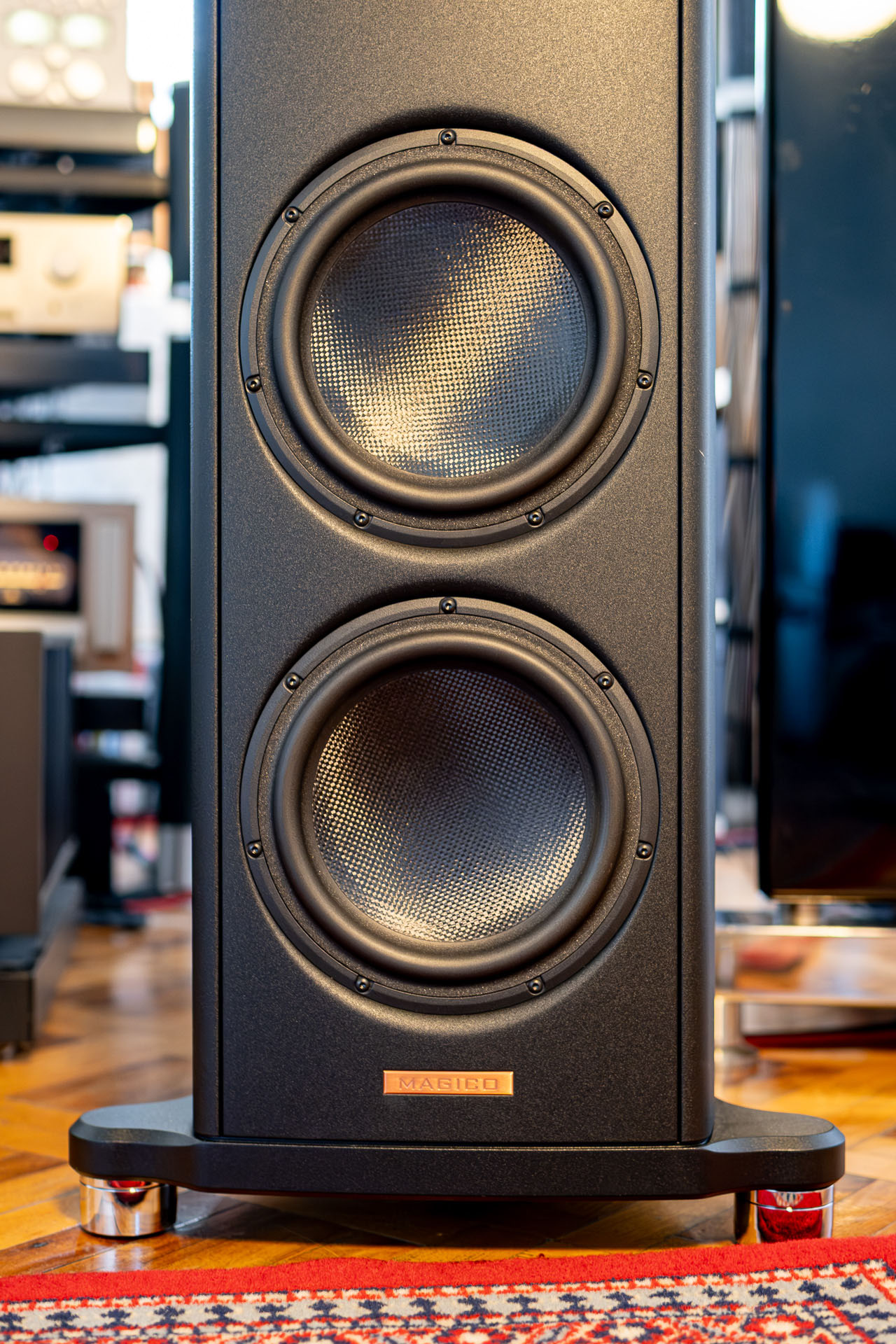
The experience of the 1812 Overture through the Magico S3 Mk III brought back memories. During my college years, we spent nearly every weekend at the Romanian Athenaeum, listening live to orchestras, chamber ensembles, and soloists performing an incredibly diverse repertoire. Those countless hours trained my ears to recognize the tonal truth, spatial depth, and emotional texture of real instruments in real acoustic spaces. So when I say the Magico S3 Mk III transported me back to the concert hall, I do not say it lightly. The speakers recreated that familiar sense of scale, nuance, and physical presence that only live music delivers. The illusion was so complete, I genuinely forgot I was listening to a stereo system, it felt as though the orchestra had taken the stage right in front of me.
The cannons were a blast too ! The ignition pop, the body of the explosion, and even a sense of the surrounding air reacting to it were all there. It didn’t sound like “sound effects.” It sounded like real artillery echoing through a vast space.
I can trully say that we fully enjoyed the whole 15 minutes of the Overture from the gentle, prayer-like introduction to the thunderous finale that left us catching our breath.
Track 1: A Different Kind of Human — AURORA

It begins as though the room’s air has shifted. From the first note we sensed the space contract inward rather than push outward, our sense of scale gently redrawn. Mastering engineers create this sensation through careful phase adjustments, carving “black holes” in the soundstage. Such nuance demands a speaker that can disappear into the mix, and here the S3 seems to reveal this capability fully.
AURORA’s voice enters with haunting elegance. Through the S3 we often forgot we were listening to speakers at all, a refrain we return to because such moments of vanishing clarity are all too rare. In that instant, we became aware of how little most systems actually reveal. Her naturally strange, otherworldly timbre remained wholly intact, the loudspeaker made no attempt to tame or sweeten its peculiar beauty. Instead, it simply laid every subtle detail bare, offering her presence with pure realism.
What also struck us was the fragility, the delicate veil of breath lacing each phrase. On many systems that breath becomes sibilant or overblown, turning intimacy into distortion. Here it emerges without emphasis or harshness. The S3’s diamond-coated beryllium tweeter extends effortlessly into the highest frequencies with no glare or shimmer. We hear only the texture of a female voice shaped by breath and emotion.
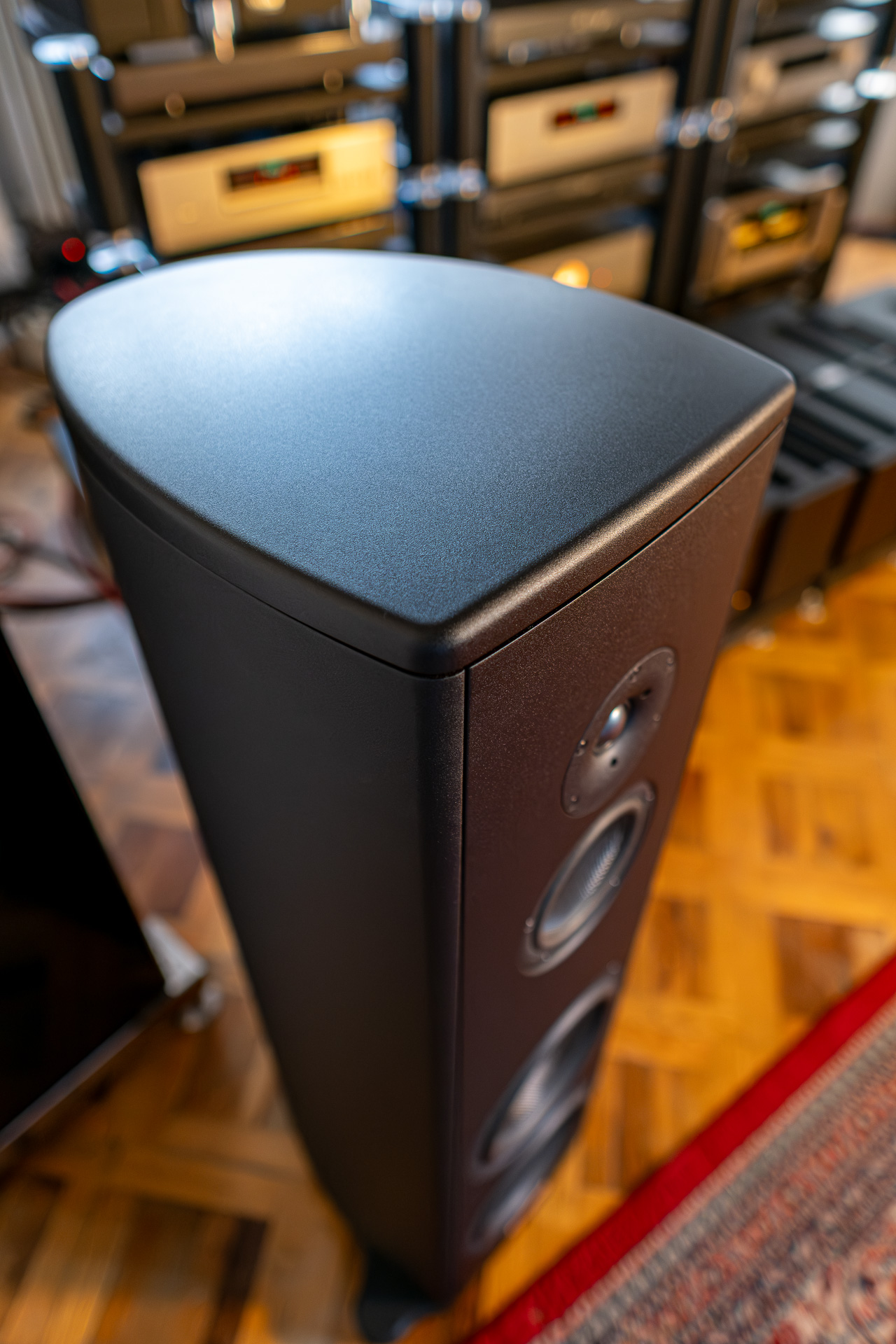
Next was the expansiveness of the soundstage: not merely wide but boundaryless, its edges dissolving into the room. Background vocals drifted behind the main voice, seated deeper into the soundfield, extending the stage until they faded away, leaving only her intimate whisper, centered and defined with great accuracy. Even as the arrangement grew denser, focus never wavered. The S3 simply revealed more of the music, layer by layer, without sacrificing precision or presence.
There’s a mid-track passage where tribal percussion unfolds in layered, almost ritualistic rhythms. We sensed each strike as a separate hand and each drum as its own resonant chamber. We say “almost” because the full impact eluded us. It goes to show that the foundation of every audio system, the room, cannot be ignored, no matter how much expensive gear you throw at it. The speaker placement was not quite perfectly tuned, this was out of our control. With more precise positioning we suspect the S3’s sealed design could offer firmer bass and stronger punch even in challenging room conditions. Even so, just imagine what a herculean task, trying to position a speaker that weighs 101kg is. In a more refined setup that we heard, it did convey percussion not just through sheer force but through fine contrasts, confirming this speaker’s potential for truly immersive rhythmic portrayal.
By the time the outro peaks, AURORA’s voice blooms into layered harmonies, processed yet undeniably human. We had the impression that the S3 does not fight artificial textures but honors them, giving electronic tones the same dignity as acoustic ones. This reveals a defining strength: no preference for one type of music. If the recording’s intent is honest, the speaker reflects it.
As the final vocal fades into reverb, the decay was felt, like a breath released after being held for too long.
We didn’t realize how fully invested we were until the final line arrived, and found ourselves holding our breath…
Track 2: Feet on the Ground — Pernille Rosendahl

At the beginning of the track, something stirs at the edge, gliding into the soundscape. It sounds like a chord, or perhaps an electronically treated string passage, but it does not arrive directly. It moves. From the far-right channel, across the center, and into the left, it traces a slow, sinuous path through the soundstage. It made us feel dizzy, just as the lyrics imply, “spinning all around”.
Luckily with the first downbeat, this track grounded us. There’s a percussive, rhythmic pulse that asks less for analysis and more for surrender. The S3 added texture so the rhythm became more than mere beat and tempo Beneath it, the bass line maintained a deceptively simple pulse, a low hum more felt than heard. On systems that lack real low-end discipline, this becomes a smear. On the S3, we felt it as an anchor. The dual nine inch woofers held the low end and released it with revealing precision. We discerned exactly when each note ended and when silence began. We found ourselves wanting a touch more punch; the bass remained admirably tight but we yearned for more.
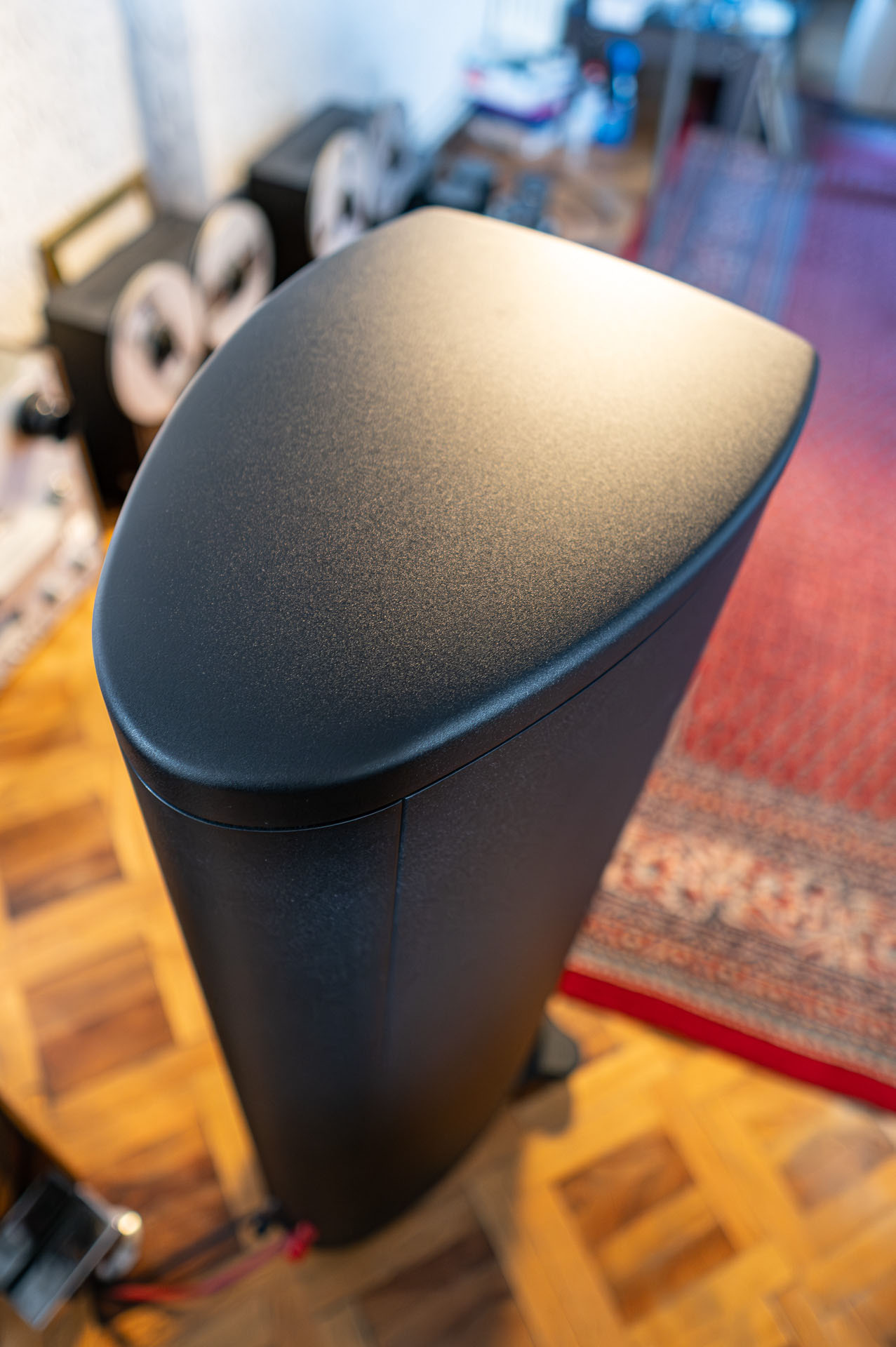
Rosendahl’s voice demands a faithful rendering or its impact feels wasted. The S3 seems to nail it. It imparts her tone with natural weight and tangible presence. A slight rasp at the top of her chest register emerges without fanfare or forced emphasis, revealed purely and directly.
The midrange performance here is astonishing. Many high-end speakers chase that elusive “presence region” sweet spot, aiming to make vocals pop without becoming nasal or hollow. What the S3 does is more nuanced: we didn’t feel she was on a stage, but in the actual room.
At 1:10 mark, just as we become accustomed with the “grounded spinning”, additional layers of pads, synths, and echoes are revealed and the track’s architectural depth becomes clear. The S3’s coherence holds firm and spatial layering stays distinct. Elements rise above the vocal plane, without ever feeling stacked or cramped. We observed three stages of dynamic range in her voice. The S3’s transient response captured each shift with almost surgical precision yet never sounded harsh, even at the end when she is almost shouting. We also noted the bass was fast, percussive but again, we longed for more.
There are a series of snare hits late in the song (from 2:24) that seem to come out of nowhere sharp, isolated, fast. We felt the drumhead’s tension, the stick’s snap, the drummer’s intent.
Rosendahl’s final phrases are delivered somewhat like a confession. The S3 renders them closer. We felt that the intimacy delivered here was not a function of volume but of space. The air around her voice became denser, the room became smaller. This was no studio trick or added coloration but the speaker laying the mix bare as it was sculpted.
When it concludes without fanfare, the resulting silence carries “weight”.
Track 3: When the End Comes — Andrew Belle
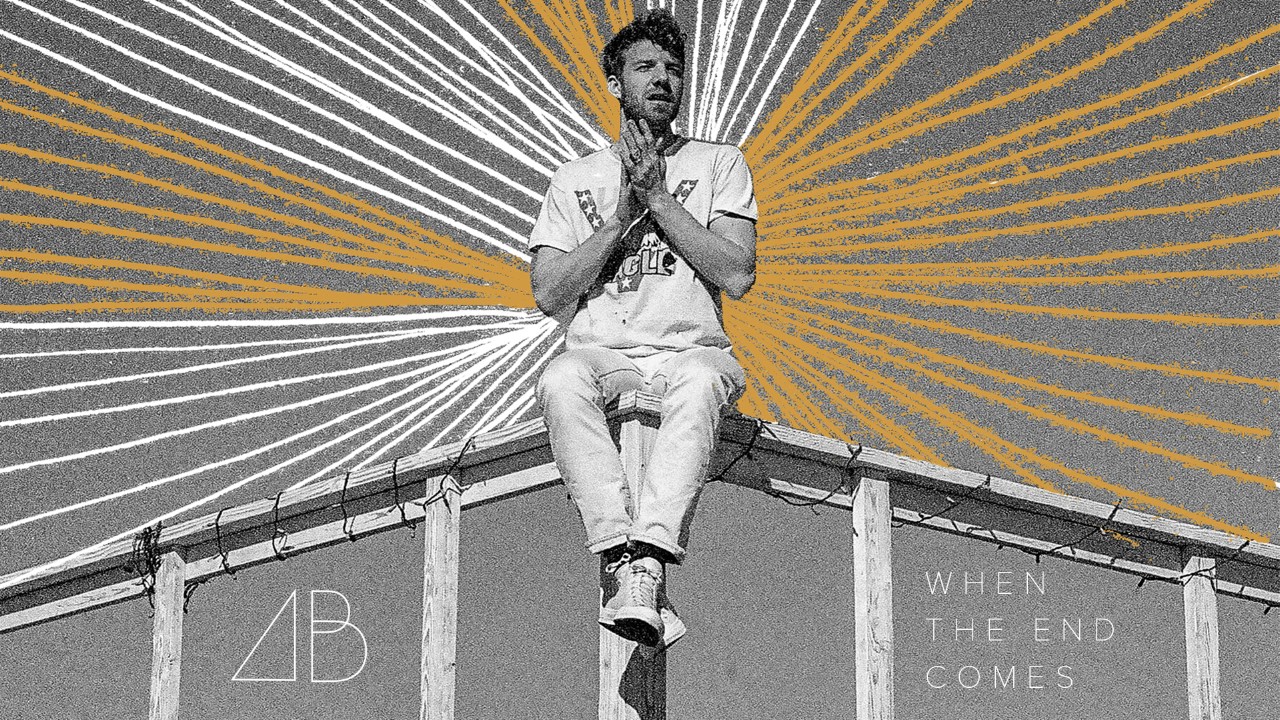
This track is neither bombastic nor overly intricate. It tests a speaker’s grace, weighing fragility against momentum.
The track opens with a softly recorded acoustic guitar, its tone lightly brushed and intimate. Many speakers render it either bone-dry, string without wood, or overly warm, masking the steel’s bite.
In contrast, the S3 presents the guitar as a complete instrument, its wooden body resonant with tension and tonal nuance, plucked by human hands. Each note arrives with purpose, blooms naturally, and fades gracefully. Nothing overstays its welcome. Nothing vanishes prematurely.
And then Andrew Belle’s voice steps into the frame.
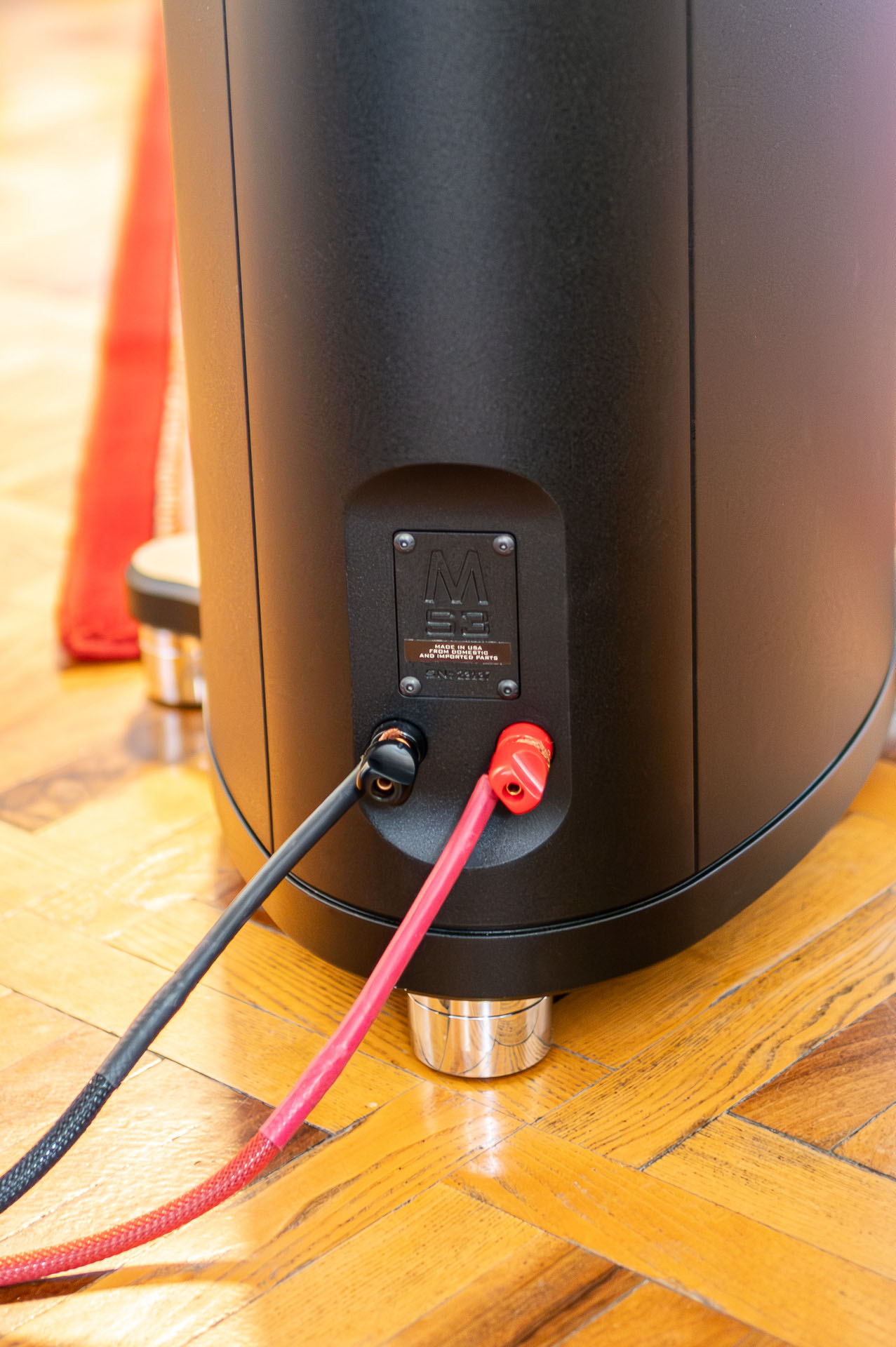
Here the S3’s coherence takes on an unsettling intimacy. His delivery arrives nearly as a whispered conversation, not breathy but hushed. The S3 reveals the contours of his phrasing, of his echo, with frightening clarity: the tightness in his throat, the half-swallowed vowels, the way he leans into certain syllables.
There’s a moment, early in the track, where background synth textures begin to stretch across the mix almost like a veil (0:43). They are subtle, humble, nearly ambient yet the S3 manages to give them structure. We perceive not just the notes but the space between them. The synths do not blur the soundstage, they expand it, pulling room boundaries gently outward, like how breathing expands lungs.
We found the kick drum soft, padded, intentionally understated. The S3’s sealed design and incredibly fast bass response does not inflate the note. The impact is clean but we found it cold at times. It’s more like tapping one’s chest with a closed palm. These speakers clearly showed us that they require a little more care from the positioning elfs, if we are to enter nirvana, riding on low frequency notes.
The track builds in layers, harmonies, tremolo guitar, percussion drenched in reverb. On most systems that is where details collapse and the mix feels crowded. The sonic ceiling starts to compress. But the S3 just enhances. There’s headroom in every dimension. Each added sound finds its own space, its own pocket of air.
The track is definitely a slow burn. A controlled emotional release. The fade out was so finely layered we barely noticed how quiet the room became, right until the very end of the track.
Track 4: Aberdeen — Avi Kaplan

Avi Kaplan does not sing, he resonates. His voice exists somewhere between breath and thunder, and it’s the kind of test that tells you exactly how honest a speaker truly is. We often use his voice as a test, as a benchmark, as a statement.
On many systems, his baritone overwhelms the mix, turning intimacy into rumble. Of course, we exaggerate to make the point clearer. In the refined realm of high-end playback that exaggeration dissolves into subtlety. What once felt like a quest for thunder becomes a search for whispers and echoes that hover just beyond notice. We cease listening for what demands attention and begin hearing what barely dares to speak.
We found the S3 anchors Avi’s baritone without embellishment. It never inflates his voice. Instead, it presents him not as a mountain overshadowing the music but as a man rooted at its heart, commanding yet quietly expressive.
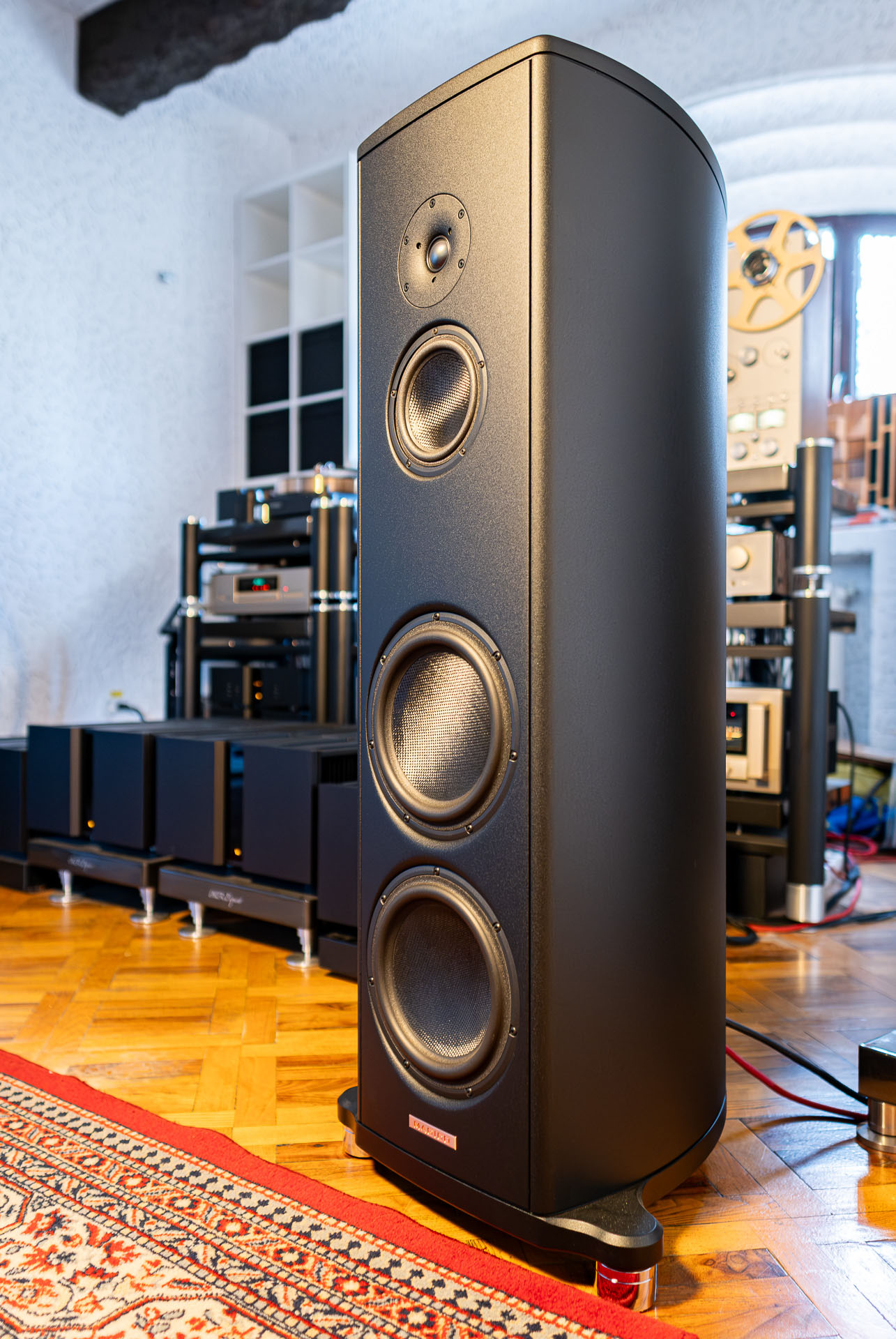
The track opens with strings, bowed with a ghostly tension, barely touching vibrato. The S3 lets them tremble, not by pushing them forward, but by refusing to interfere. With no cabinet resonance that we could pick up and no background noise, these fragile tones gain true autonomy. They never scream for attention. It seemed as if the harmonies float in their own space with gentle authority.
Avi’s vocal line is delivered with such natural weight that we forgot it’s coming from a transducer. We heard the body behind the tone, the chest cavity, the diaphragm. This is not a trick of tonal balance. We believe it is a result of transient fidelity, the speaker’s ability to stop and start exactly timed with the signal. Midway through the song (0:50), harmonies emerge behind him like a choir. We heard not just pitch separation but true spatial layering, voices unfolding in depth around him.
At the song’s climax (2:20), there’s a rising surge of low-frequency energy, sub-bass, harmonics, layered voices, ambient rumble, whistling and each of these appear one by one adding more and more dynamic range just up until the end. We have heard many speakers falter at this peak, their drivers struggling as the torrent builds. The S3 remains composed. It meets the challenge without hardening or hesitation, retaining immense scale and preserving musical form.
Track 5: Euphrates – Govi

The opening notes of “Euphrates” immediately set a captivating mood, with Govi’s guitar weaving delicate patterns of melody and rhythm. The guitar strings, plucked with masterful precision, are presented with an almost tactile realism. Through the S3 the midrange offered transparency bordering on the uncanny: every nuance of resonance, lay exposed before us.
Most speakers either overly emphasize body warmth or chase string snap at the expense of natural tone. They tend to favor a brighter voicing that renders this track with artificial hardness and forced sheen.
The S3, by contrast, manages to achieve perfect balance without coloration, relying on the seamless union of its midrange and tweeter to present guitar tone as an unbroken whole. Notes flow naturally into a decay that feels organic, as if the guitar is still vibrating the air around you and the vibration is coming both from the string and the body. This decay isn’t a simple fading of sound; it is a living, breathing exhalation that sustains the music’s emotional momentum and the S3’s midrange and tweeter duo renders it with natural ease and finesse.
What truly distinguishes the S3’s performance on this track is the extraordinary richness of the shimmering harmonics and subtle overtones that dance above the fundamental notes. Unlike many systems where high frequencies can become exaggerated or sibilant, here they are delicately balanced, detailed, smooth, sparkling but never sharp.
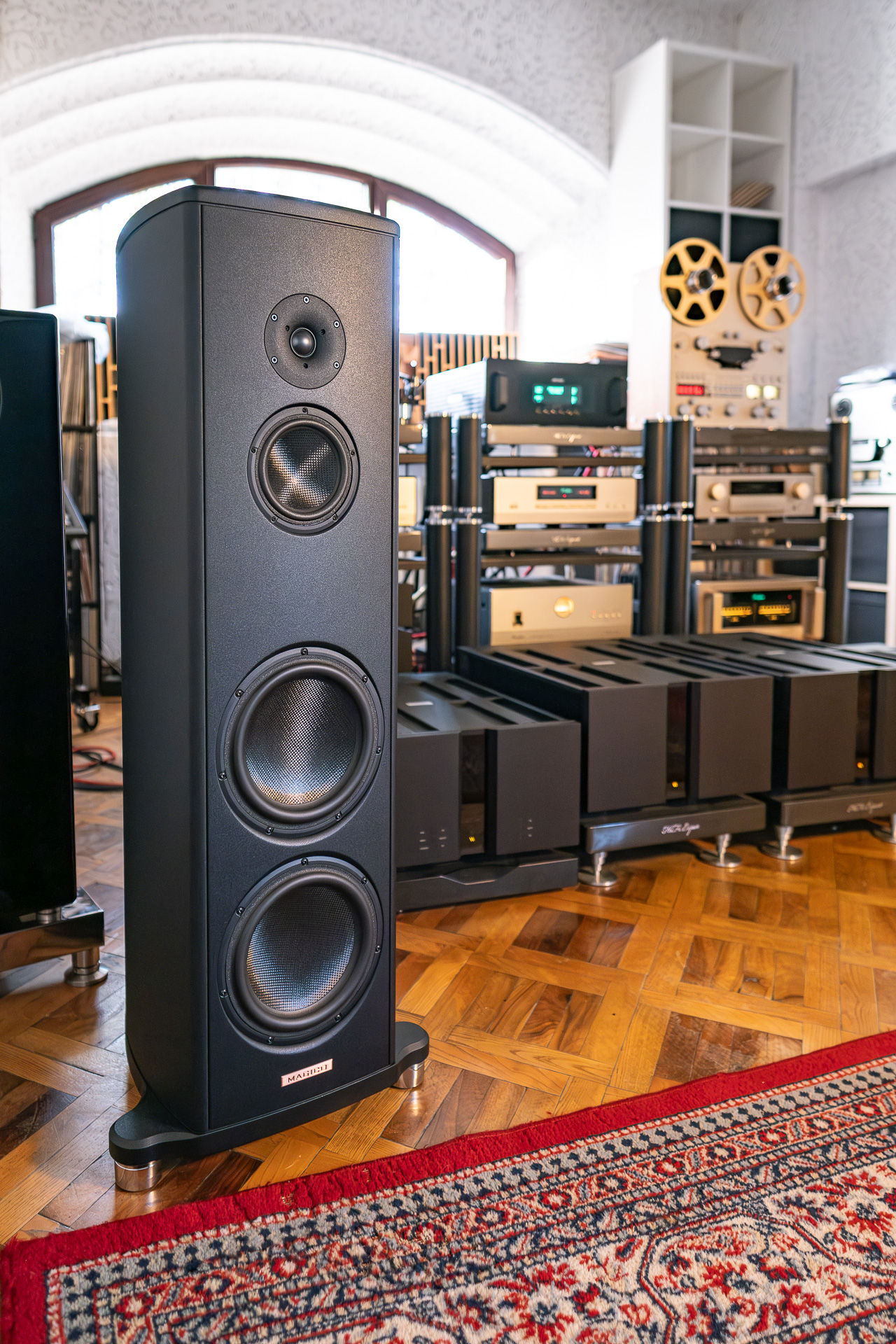
The spatial presentation is equally impressive. The soundstage is wide for the clicks and pops yet intimate for the strings and the drums. The S3 doesn’t just reveal the presence of instruments; it reveals their position, their shape, their movement in space.
Supporting the melody is a subtle yet lively percussion section, which the S3 renders with tactile exactitude. We appreciated the precision yet felt it lacked the muscular weight this track demands. The bass and rhythmic elements add momentum and texture to the track but we needed more, mooore. Just as Smith called for more agents, so did we… we were calling for more elfs to help us with the repositioning, but they never came, sadly. The sealed cabinet although maintaining impeccable control, delivering low frequencies with depth and definition, barely managed to add the gravitas we expected.
Listening to “Euphrates” on the S3 showed us how true high-fidelity can engage mind and heart. Its exceptional dynamic range reveals microdetails without turning analytical and presents expansive space without ever feeling sterile, elevating the listening experience from mere reproduction to something transcendent.
This is a system that lets music live in your room as a shared presence rather than a phantom illusion.
Track 6: The Mystic’s Dream — Loreena McKennitt
“The Mystic’s Dream” is an intricate tapestry of sound, a complex layering of ancient instruments, ethereal vocals, and spacious ambience. The Magico S3’s performance on this piece is nothing short of revelatory. From the first toll of the bells, the speaker establishes an acoustic environment that feels vast, cathedral-like in scale backed by a dynamic range matching the very best of speakers, bringing each layer to life without congestion. The decay of the bells is felt, creating an enveloping resonance that seems to linger in the air, evoking a feeling of cavernous spaces.
Loreena McKennitt’s voice enters the mix as both a guiding light and a haunting presence. The S3’s midrange driver yields completely, revealing every ethereal nuance with remarkable emotional depth. Every breath, every subtle inflection is rendered with naturalness, making the performance feel deeply personal. This is not a filtered vocal line, but a fragile, intimate yet powerful human presence laid bare.
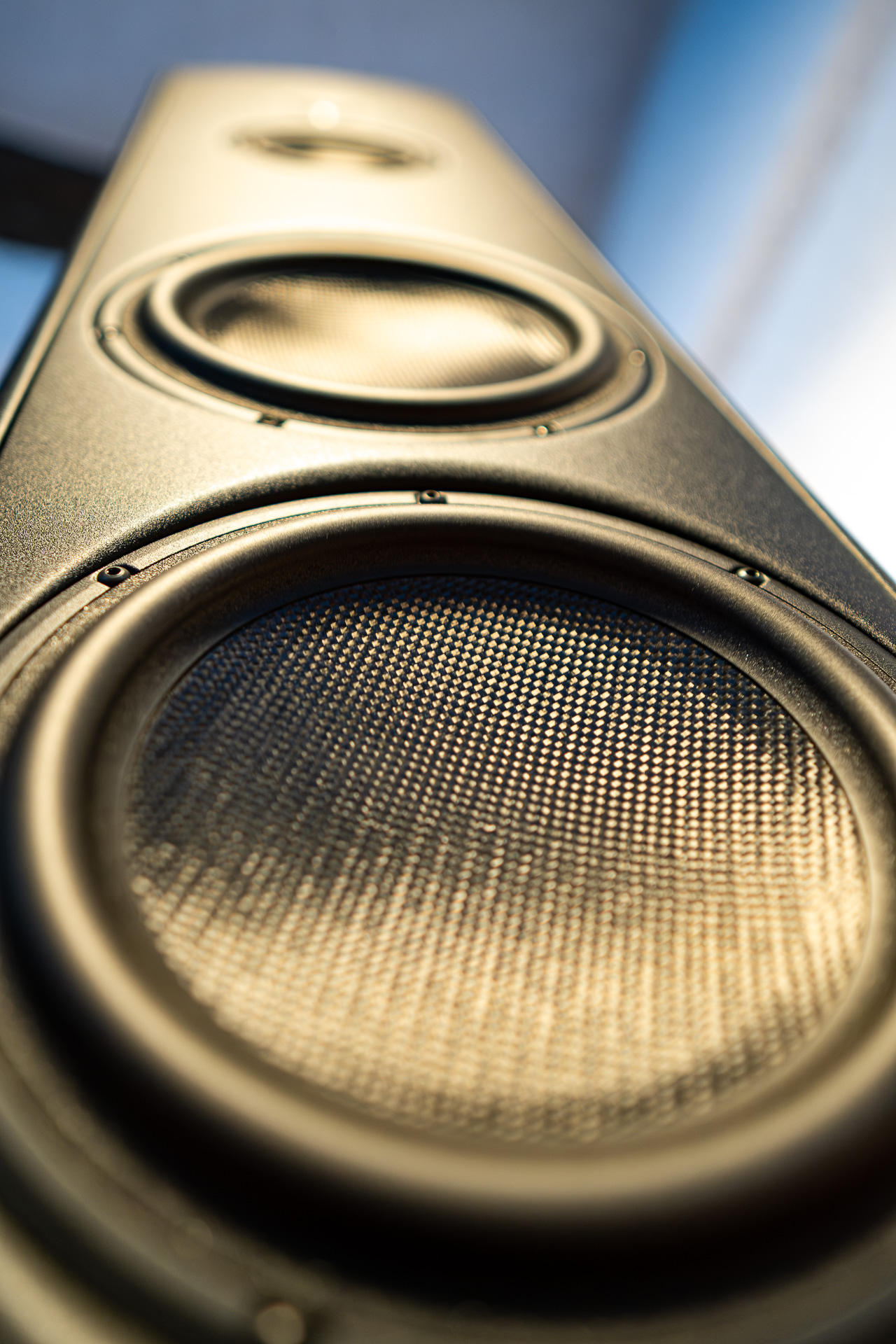
The S3’s ability to differentiate the layers within this dense arrangement is exceptional. Frame drums deliver a heartbeat of force and precision without dominating. We sensed the qanun’s crystalline shimmer, its delicate plucks sparkling through the mix. Backing vocals weave in and out with a transcendent quality, each occupying its own distinct space in the expansive soundstage. What could have been a cluttered mass of sound, often heard on many speakers, instead became a carefully constructed sonic architecture where every element breathes and interacts naturally.
We found ourselves wanting more heft in the low end. It stayed tight and defined, reinforcing rhythm and emotional weight without blurring higher registers, yet we longed for deeper presence. Even so, the S3’s composure never wavered during powerful crescendos, navigating complex transient shifts with ease and showcasing its superb dynamic range. Its restraint hinted at even greater potential when driven harder. Of course, bass depth often depends on room acoustics, and sometimes, as enthusiasts note, it is what it is.
The mix of exceptional dynamic range, high-resolution detail, analytical precision and harmonic subtlety in this piece makes it an ideal proving ground for any speaker’s ambition: to strip away artifice and expose music’s purest core as raw, pure emotion.
Conclusion
Now to conclude: one of the most striking aspects of the S3’s reproduction is its coherence across the entire frequency spectrum. The crossover transitions between drivers disappear without a trace. We never perceived disparate parts struggling to work together. The music always flowed as a unified whole, effortlessly, with timing and rhythm that felt utterly lifelike, no matter the type of music played. We know these words risk sounding grand, yet, in our experience, they ring true.
We also discovered the S3’s dynamic range to be out of this world. The kick bass delivered chest-caving power that remained palpable even at low listening levels, something very few speakers can achieve. At the same time the highs emerged pure and entirely free of sibilance, preserving every shimmer without harshness.
This remarkable integration allowed us to immerse ourselves entirely in the moment of performance, no matter the genre played. We often felt as if the performance, play or concert were unfolding in real time in our own room. We all know the power a live show has, it inspires reverie and often makes tears appear out of nowhere. As is the case here, the tears came without warning.
Special thanks go to HiFi Expert for their support in making the photo shoot possible, and especially to Iura, a man of rare kindness, with a genuine passion for music, always gracious and open-hearted. We thank him for his generosity, his patience, and for the warm atmosphere he created (even though the AC was on full power mode).
It’s always a true pleasure to work with people who put their heart into everything they do.
